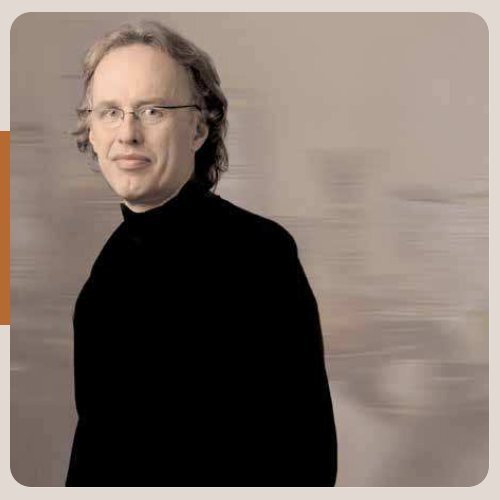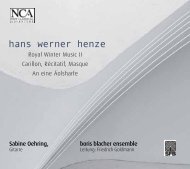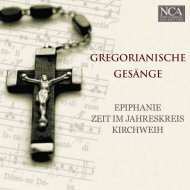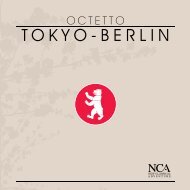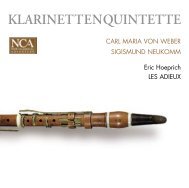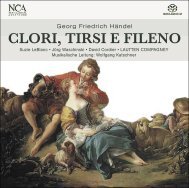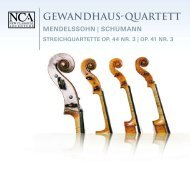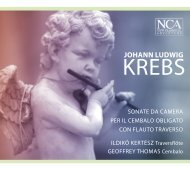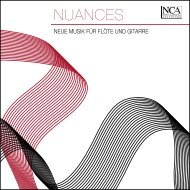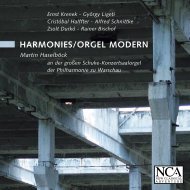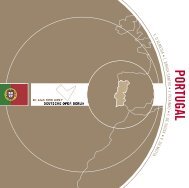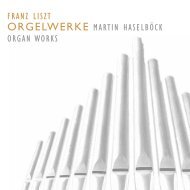JOHANN VON HERBECK - nca - new classical adventure
JOHANN VON HERBECK - nca - new classical adventure
JOHANN VON HERBECK - nca - new classical adventure
You also want an ePaper? Increase the reach of your titles
YUMPU automatically turns print PDFs into web optimized ePapers that Google loves.
38<br />
It truly is the brilliance of bygone days that Herbeck conjures up here – as in his<br />
Organ Symphony: Variation VI of the Symphonic Variations is reserved for the<br />
ultimate test of polyphonic composing, a strict double counterpoint made up of<br />
two autonomous voices which accompany each other. The middle section of the<br />
Allegretto makes up a lovely contrast to this – a trio with bucolic idyll of the<br />
woodwinds and bourdon fifths in the basses. The Baroque combination of<br />
Prelude (Variation XI) and Fuge (Variation XII) is also important to Herbeck in the<br />
Symphonic Variations; he finishes the cycle with these forms.<br />
However, the gently-flowing theme – characterised in an unmistakeable fashion<br />
by an octave jump upwards – is also joined by variations which, as in the case of<br />
Symphony No. 4, document influences from the two main late nineteenth century<br />
music trends. Herbeck’s son Ludwig not only mentions the finale from<br />
Beethoven’s Eroica but also Robert Schumann, whose variations cycle of his<br />
Symphonic Études for Piano served as more than just an inspiration for the title of<br />
Herbeck’s variations. In addition, Johannes Brahms – whose Haydn Variations<br />
had been written some two years earlier – keeps getting a word in regarding<br />
instrumentation and expression, for example in Variation V and Variation VII;<br />
Herbeck’s Symphonic Variations are dedicated to Eduard Hanslick, the critic ‘god’<br />
from Vienna who was also a friend of Brahms.<br />
In the Scherzo (Variation X) however, the influence of Anton Bruckner – who<br />
MARTIN HASELBO¨CK<br />
Hanslick always fought against – can be felt everywhere. An elaborate structure<br />
(with the exception of the finale, the scherzo is the longest variation in the cycle),<br />
orientation As conductor on and stamping organist, Upper Martin Austrian Haselböck folkdances is present in the on Scherzo the international and leisurely music<br />
Ländler scene in in a the number trio as of well capacities. as rhythmically Decorated structured with prizes expanses won at of international sound from the<br />
full competitions, orchestra characterise he gained an the excellent movement; reputation only the as scherzo’s a soloist early gently on dying his away career<br />
ending – following has completion no single model of his in studies Bruckner’s in Vienna work. and Paris – and has performed<br />
under the baton of conductors such as Abbado, Maazel, Muti and Stein. Martin<br />
With Haselböck his Symphonic has recorded Variations over fifty Johann solo CDs von Herbeck and numerous created important a cycle whose composers<br />
individual – including movements Ernst Krenek, were Alfred not Schnittke only inspired and by Cristóbal different Halffter stylistic – periods have dedicated but<br />
which solo works in addition and concertos reflected to extremely him. Today, different he is characters still a regular – such guest as performer the bright as a<br />
strolling soloist at semiquavers the world’s important of the Allegro music moderato centres (Variation and in 2005 III), will the be romantic, giving major dreamy<br />
Canzonetta, organ recitals the at melancholic the Gewandhaus Adagio in with Leipzig, its lively the Disney middle Hall section, in Los the Angeles humorous, and<br />
playful the Konzerthaus Scherzino in or Vienna, the serious, among solemn other Andante venues. (Variation IX). Nevertheless,<br />
through the unifying influence of the ever-present theme, they form an integral<br />
symphonic In his capacity whole; as court together organist with the in Vienna, Organ Symphony Haselböck’s these occupation variations with make the up<br />
Herbeck’s extensive repertoire major symphonic of <strong>classical</strong> works. church music marked the beginning of his<br />
dedication to conducting, leading to the formation of the Vienna Academy<br />
(Wolfgang Ensemble in Doebel 1986. – With translation: his orchestra, Steven Haselböck Clark) stages a cycle of concerts<br />
annually for the ‘Gesellschaft der Musikfreunde’ (Society of the Friends of Music)<br />
in the Great Hall of the Vienna Musikverein. Guest performances have taken him<br />
to the major music centres of Europe, U.S.A. and Japan for years and as an ‘Artist<br />
In Residence’, Haselböck has already appeared with the Vienna Academy at the<br />
39 23


